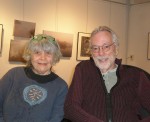Olga Campbell and Larry Green’s shared exhibit at the Zack, Hidden, is on until March 6. (photo by Olga Livshin)
In the new exhibit at Zack Gallery, Hidden, the pieces are united not only by theme but also by media. Both artists featured, Olga Campbell and Larry Green, mostly use photography, which they then play with in Photoshop. The computer-generated effects contribute to the graceful and faintly mystical feel of the images. Hazy silhouettes hide behind the splashes of paint. Eyes peek through the veil of the unknown. Mysterious places and partial faces open the gates of subconscious and let us witness the artists’ creative cores, their emotions.
The images are distinct, echoing each artist’s personality, but the common approach makes their double show almost seem inevitable. And the meshing of their artistic visions spills into life beyond the gallery. Both chose careers in the helping professions, for example. Campbell was a social worker until she retired. Green is a psychotherapist and a professor of psychology. But they didn’t really know each other before the idea of a mutual exhibit took root.
Campbell explained how it happened: “Last year, I participated in Culture Crawl. Linda Lando, the Zack Gallery director, came to see my pieces. She asked me if I wanted to have a show at the Zack Gallery.”
Green added: “I was with Linda that day – we are partners. I remembered Olga’s art from other shows…. I like what she does. Someone suggested we have a show together. That’s how this collaboration started, but, even before that, we were vaguely aware of each other. We saw and admired each other’s art at group shows. We knew many of the same people: friends, neighbors, co-workers.”
After the dates of the exhibit were set, the artists met to decide on the theme. “Larry came up with the Hidden, and I thought it was wonderful,” said Campbell. “There is so much in the world that is hidden. People hide things from others and from themselves, adopting layers of masks and veils. When we put obstacles in the way of seeing the world, we hide not only the shadows, but also the light. When we acknowledge the shadows, then we are able to see the light. Most of the really profound and rewarding things in life are hidden beneath the layers of mystery.”
In Campbell’s pieces, the layers are frequently photographs superimposed upon each other in Photoshop, plus special effects and the occasional addition of multimedia. She admitted that she doesn’t do much pure painting although she studied it.
“I always liked doing art,” she said. “In 1986, I took several art classes and then I thought, what to do with it? So I enrolled in Emily Carr. Afterwards, I worked as a social worker part-time and on my art part-time, until I retired. Art is not a hobby for me. I have to do it.”
Green’s path was a bit different. “I did a lot of art until I was about 25. Then I dropped it for 20 years before starting again, first with pottery and then with other stuff. When I worked with clay, sometimes my hands knew better than my brain what I wanted to say. I made a sculpture and now, years later, I look at it and think: Oh, that’s what I meant. Of course! My brain has caught up with my hands.”
The intuitive application of their skills underlines both artists’ creative courage. They are not afraid to experiment.
“I play around with Photoshop,” said Campbell. “I don’t know it very well. I try different things and I often get something I like by accident. Later, I can’t always reproduce the effect, so I never repeat myself.”
Green concurred. “I like Photoshop,” he said. “I learn it as I go. My ideas pull me through the learning process…. Using Photoshop, I can realize my vision much faster than with paint and canvas, but it is all trial and error. I keep worrying at the piece until something comes along. Or not. If it comes, I go for it. If it doesn’t, I don’t. Some pieces take years to come together. For example, years ago, I saw a single pink running shoe in a park and snapped a photo of it but I didn’t do anything about it. Then, recently, in a different place, I saw a single pink glove, and photographed it. I brought them together in Photoshop, and now they are not lonely.”
Many of Green’s pieces at the Zack are foggy landscapes. “I’ve always been fascinated by fog,” he said. “A foggy landscape has a particular dreamlike quality to it. Shapes are indistinct and, therefore, invite the viewer in, in an attempt to give the scene some definition. Alternately, the viewer can rest in the soft tranquility of the scene rather than be overwhelmed by details…. People who come to me for therapy are often afraid of the fog, especially inside themselves, but they’re also interested in it, in what it might reveal. Everything I do, in both art and psychology, is basically the same: trying to reveal the underlying reality, the hidden connections behind the apparent.”
“The same for me,” Campbell agreed. “Although not everything should be revealed. Some parts of the whole are better hidden, while the essence should be revealed.”
Olga Livshin is a Vancouver freelance writer. She can be reached at [email protected].

